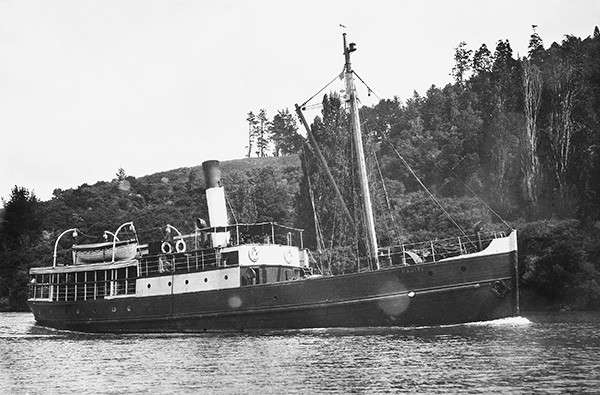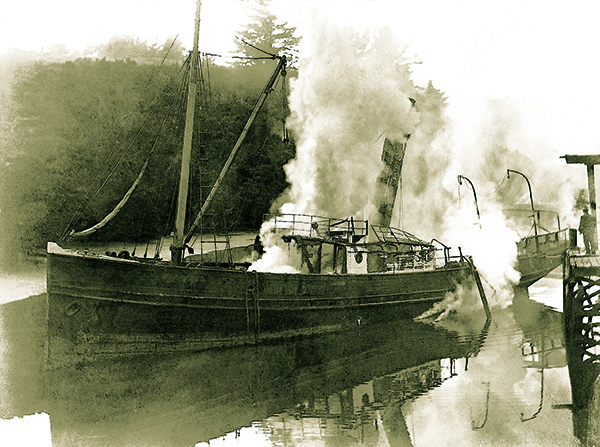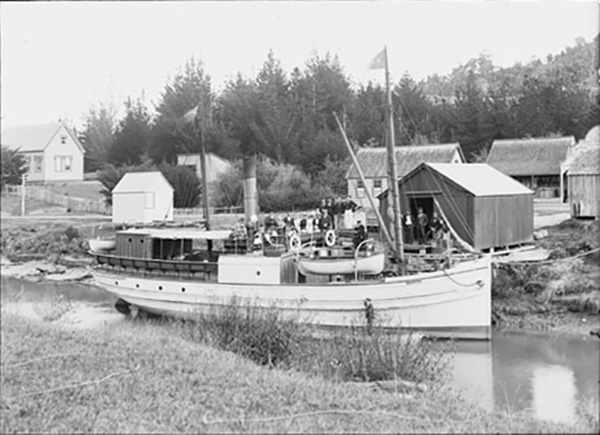Jade River: A History of the Mahurangi
Ronald H LockerFirst published 2001. Published online 2014–. This online edition is a work in progress…
Pages 164–168in printed edition
Lifeline of the north

Last Mahurangi River Lifeline: Built in 1911 for the Northern Steamship Company for the Mahurangi run, the Hauiti inherited the engines of the incident-prone Kapanui. After being retired from the Warkworth run, she completed almost two further decades of service, including to Milford Sound, before being wrecked in Cook Strait, with the crew rescued by the last captain of the Wahine. image Tudor Collins – Brian Collins Collection
The Northern Steamship Company was the brainchild of Captain Alexander McGregor, another shipwright, mariner and entrepreneur of the Nova Scotian breed, who had come to New Zealand by way of Australia.
In 1847 he built a small schooner, the Random, in Coromandel Harbour, in the bay that bears his name. He then traded successfully to the north with several vessels. Darrach built the schooner Bonita for him in 1873. Like Casey, he committed himself to a future in steam. Niccol was commissioned in 1879 to build him a ketch-rigged screw steamboat, the Rowena. Its success prompted partnerships in six more steamboats. He soon saw that his various syndicates should be formed into one strong company. This was achieved at a meeting in Auckland in May 1881. Leading merchants, developers and shipowners figured on the board of directors. At first McGregor managed the shipping from a shed on Queen’s Wharf. Four ships were purchased locally, and two, the Clansman the and Gairloch, were built to order in Glasgow in 1884.
In the next few years the great names of the city began to tumble. In this depth of depression, the new company almost folded. McGregor was replaced as manager in 1887. The new manager, Charles Ranson, rejected the scale of wages agreed by the New Zealand Seamen’s Union and the other companies, and had a walkout on his hands. The fleet was then manned with ‘free’ labour, but next year the company compromised. Nevertheless, Ranson’s general acumen and improving times reversed the company’s fortunes. Trade picked up and the fleet expanded. In 1889 the company occupied its new offices in Quay Street, looking out over its own Northern Wharfnow Marsden °Wharf and a fleet of green hulls with black and white funnels. The company thoroughly justified its name. It served every conceivable port, and places much less than a port, as far as Parengarenga. It also served the Hauraki Plains, the Coromandel, the Bay of Plenty out to Ōpōtiki, and the west coast from the Hokianga south to Whanganui. The first two decades of the twentieth century were its heyday.

Fiery End Following Brutal Rivalry: Steamboat Kapanui burns at the Warkworth town wharf, 1909. Prior to this final disaster, she had twice collided with rival McGregor Steamship Company vessels: in 1899 in a collision with the Rose Casey while competing to pick up passengers off Rodmersham, Mahurangi Heads; and in 1905 when she was run down by the steel-hulled Claymore off Devonport Wharf, Auckland, drowning five crew members. By the time she burnt at Warkworth, the deadly rivalry had played out, with the struggling companies merging and then being bought by the Northern Steamship Company. image Warkworth and District Museum
The Kapanui continued the Mahurangi run under the Northern Steamship Company flag until it burned to the waterline at the Warkworth wharf in 1909. Even then its engines enjoyed a reincarnation, as marine engines were wont to do, in the Hauiti.
The timetable for the Rodney coast in 1920 offered the following “proposed sailings, weather and other circumstances permitting” from Quay Street and Railway Wharves:
For Gruts (Ōrewa House, landings by whaleboat), Waiwera, Mahurangi and Warkworth: ss Hauiti. Monday, Wednesday and Friday (see daily papers). Tidal port.
For Kawau, Leigh, Pakiri and Mangawai: ss Kawau. Every Friday (see daily papers for times of departure). Tidal port.
For Matakana and Algies: ss Kotiti. Mondays (see papers). Tidal port.
For Puhoi: ss Kotiti. Fortnightly. Tidal port.
The arrival of Kotiti in Pūhoi was a social event. A swing bridgewhat bridge engineers term a swing bridge, wherein the bridge pivots 90° in the horizontal plane, as opposed to the simple suspension bridge New Zealanders refer to as a swing bridge on the Great North Road allowed the steamboat to pass up the Pūhoi River. When the vessel hit the bridge in 1915, the road north was closed for six days. The great Pūhoi flood of 1924 swept the bridge away.
The above schedule reminds us that the services had to fit the tides, and often meant negotiating in the dark, narrow winding creeks that were enough of a challenge in the daytime. For many years, the McElroys kept a lamp in their strategically placed window when the steamboat was expected at night. There were a few other aids to navigation: a red buoy off Dyers Creek, a black buoy off Cowans Bay, the famous ‘corner stake’ where the channel swings into the confined mangrove creek, and, no doubt, an array of lesser stakes to define the channel up river.

Kotiti Closer of Roads: When the Kotiti collided with the Pūhoi swing bridge—an opening span bridge, pivoting in the horizontal plane—the main highway north was closed for six days. She called at Pūhoi only fortnightly, but weekly at Algies Bay Matakana, where, in 1906, while approaching the wharf in the dark, she lost a 19-year-old deckhand overboard; drowned. In 1931, long after retiring from the Pūhoi–Matakana run, the Kotiti was lost with all hands off the West Coast. image Auckland Museum
For the crews, life was not as hard as that of the scowmen, but neither was it easy. The company had a good reputation as an employer and won loyalty, but conditions were rough. The crew ate sitting on hard wooden forms at a table wedged between the hawser ducts, slept when they could in cramped bunks layered against the slope of the hulls, and used toilets and cold water in a little hutch on deck. The coal bunkers took up about a third of the potential cargo space, to the detriment of the steamboats’ economics, and were so dangerously close to the boilers that it was common practice to leave a hose running in the bunkers when a vessel was tied up with steam up. Most of the hulls were wooden, many inherited from long-vanquished rivals. It was not surprising that they sometimes caught fire, although only two burned.
The Northern Company, as its predecessors had done, earned revenue outside its schedules, by running day excursions, ranging from Waiheke to Mansion House and Warkworth. These were immensely popular in their time, and must have been money-spinners. I can just remember one on Rangitoto to Motuihe. There were also weekend excursions and an annual cruise to the Great Barrier and the far north. The Mahurangi Regatta provided a regular excuse for an excursion. A steamboat was even despatched to Warkworth to convey the annual school picnic to Waiwera.
The last of the Mahurangi steamboats were the Kawau, the Hauiti and the Omana. Indeed these were the company’s last three passenger vessels.
The Hauiti (148 tons, 100 feet) was built for the Warkworth trade by Niccol in 1911. Maurice Edwards remembered her on her maiden voyage:
…coming up the river with a full dressing of flags up.
At 18, he briefly joined her crew:
When she turned around at Warkworth wharf, the stern would be hard up in the corner by the steps and the bow would brush the trees on the other side of the river.
She was wrecked in Cook Strait in 1954. Last to serve the Mahurangi was the Omana, which falls within my own span of memory. She was another wooden Niccol ship (83 tons, 78 feet), named for a place on the Northern Wairoa, where she had been run by her builder. She was brought from the Kaipara in 1922, one of only three vessels to be added to the passenger fleet after the First World War.
The onset of the depression coincided with competition from the roads. The main north road was metalled to Warkworth in 1933, and service cars began taking passengers and mails from the ships. The railways cut freight rates at a time when the flow of farm products and inputs was shrinking. By March 1931, eighteen Northern Company ships were laid up and ten services cancelled. Some ships went to the Japanese breakers. Many faithful servants saw the security of their jobs vanish.
The Omana’s schedule for Mahurangi declined from thrice to twice weekly, and finally just once. She would stop off Motuora to service the Emtage family, who farmed the island. On 20 February 1937 she was withdrawn from service, and as if to emphasise finality, was immediately offered for sale. There was no buyer. Two years later she was dismantled. Her hull mouldered away in the mud of Ngataringa Bay. So ended 66 years of essential service by the steamboats of a succession of companies, to the people of the Mahurangi.
The wharf at Scotts Landing had shared the decline. It was in such a bad state in 1914 that citizens waited on the visiting premier, Massey, asking for its repair. William McElroy junior wrote to an editor in that year that it was time the government put some of the revenue it earned from licences for picking the local oysters, back into the wharf, over which the sacks of oysters passed. By the early thirties the end was in sight, and no money was being spent on this wasting asset. I have a childhood memory of that time, of how it swayed as the vessel tied up, while the locals prudently retreated from the tee, remembering an earlier occasion when part of it had gone with the vessel. The tee and most of the approach were later demolished after a further accident and the shed relocated on the stump. It was then no more than a launch wharf, and steamboat passengers had to be picked up in the stream.
The last word on the service comes from Nora Weakley, who looked out from the McElroy house, one morning after a blow, and was surprised to see the decrepit wharf, shed and all, going past, making its valedictory appearance as it drifted out on the tide. Today, few motorists who reach Scotts Landing at the end of Ridge Road, realise that they are parking on the reworked abutment of the old wharf.
World War II wrote finish to the steamboats of the company. My last journeys on them were on my first tramping trip, to Great Barrier in 1945: out on the Kapiti and back on the Motu. A fleet of much larger modern ships was acquired to compete in the wheat trade to the South Island, but failed in competition with the entrenched Union Steamship Company. When the last three ships were sold in 1975, the ‘lifeline of the North’ had completed almost a century of honourable service. It had sustained life in isolated coastal settlements, contributing profoundly to the development of the entire province and its city. The handsome old building in Quay Street, still bearing its name, is its surviving monument. Carrying Heritage New Zealandat time of writing: New Zealand Historic Places Trust Historic Place Category 1 classification, it is still in some peril from present grandiose plans for redevelopment of the waterfront. Its Victorian bricks deserve to stand just as much as the renovated Auckland Ferry Terminal.
The city owes no less to the record and the memory of the Northern Steamship Company.
